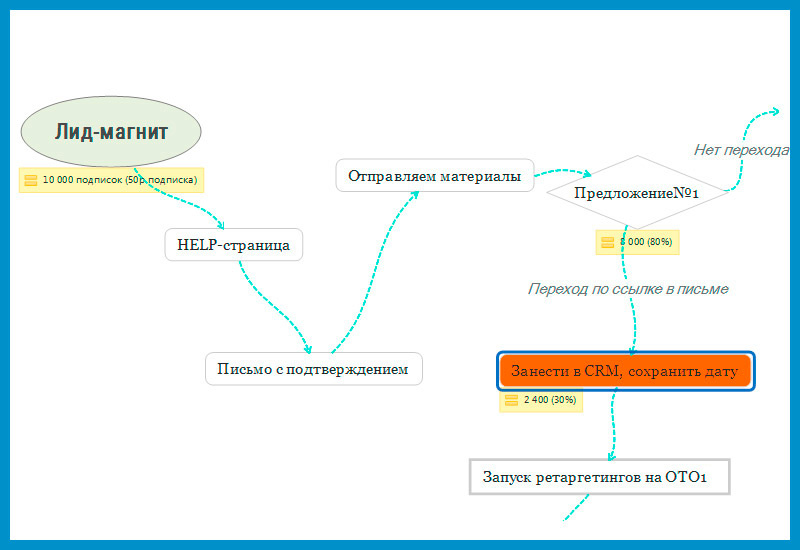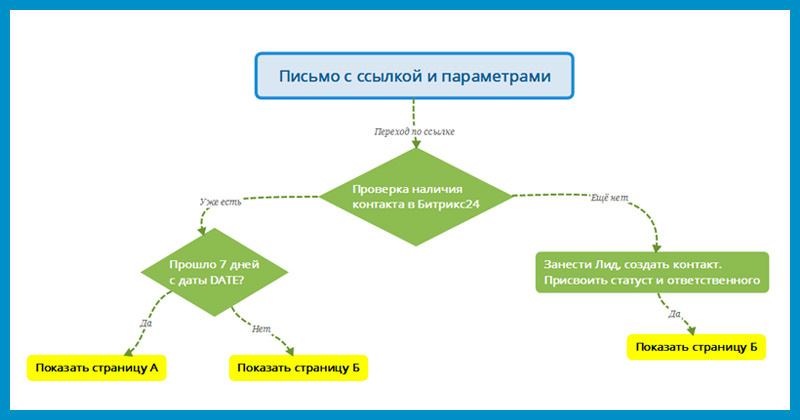Automatic Sales Funnels: Technical Implementation
Today I would like to raise the issue of technical implementation of auto-funnels. And pay more attention to the example of a bundle of several services. For example, CRM and funnels. In this article, I propose to consider several solutions embodied in life.
What are automatic sales funnels?
In order not to overload the text with background information, I propose to leave it outside the bracket. If you are not familiar with the term and would like to start studying the topic from the very beginning, then I recommend starting, for example, from this post. They also recently published a concept on how automatic sales funnels can solve the problem of launching sales in new branches . It illustrates the use of auto funnels in life.
CRM Integration
Integrating services with each other is a typical task in developing automated marketing funnels. In some cases, you can do without programming: there are services like zapier.com, which can link several tools by default that do not provide for integration with each other.
For example, we want to collect contacts on Facebook Lead Ads and immediately transfer them to the mailing service Mailchimp, Unisender or GetResponse. Another option is to organize surveys using Google Forms, save data and send the mailbox to the subscription service.

Organization of the collection and exchange of data using services can significantly increase the speed of the implementation of new ideas. And, literally, improve them every day.
When a team of several specialists and a project manager from the field of marketing works on a project, everyone is in the know. As soon as a mistake or obvious improvement is discovered, everyone can just go in and fix it. Without the standard chain, "set the task to the programmer -> assign priority -> wait for application." This pleases both developers who can focus on new tasks, and a team that quickly affects the performance of the auto-funnel.
A similar solution works when you need to create a simple bunch with a direct logic: "take it here - save it there." Let's now look at an example when we implement logic together with developers.
Bitrix24 + Unisender
In one of the craters, the following logic was laid in our place. After the subscriber receives the materials of interest to him, we send him the first personalized offer. It must be valid for 7 days, and then become inaccessible.
Used CRM: Bitrix24.
Email Service: Unisender.

The first elements of the funnel
How to solve such a problem, and what should be envisaged?
- When clicking on a special link, we need to automatically create a Lead in Bitrix24.
- At the same time, it is important to provide protection so that our customer base is simply not “spammed” by substituting 1,000 non-existent email addresses.
- It is necessary to fix the date of transition. We will count from her 7 days when the proposal ceases to be valid.
- The link should be unique and “burn out” in a week. In this case, when clicking on the link, the script should check for the presence of the corresponding Lead. If there is, check the date; if not, create a new Lead.

The logic of the script for the starter offer
We solved the problem together with development partners from Manao. Separately for each item:
1. Creation of Lida in Bitrix24. The mechanism is simple - in the links in the letter that Unisender sends, we insert two parameters: {{Email}} - the recipient's email and {{SendDate}} - the date the message was sent. A complete list of options that can be used is here .
Using these parameters, when clicking on the link, we get to the page with the sentence where our script is located. Its task is to create a Lead in Bitrix24 through the API.
Notice, we transmit the date of sending the letter. Thus, if the person concerned does not immediately follow the link, but, say, after 2 days, then everything will be saved correctly. And he will have only 5 days left, as was written in the letter.

Leads produced in this way are created with a specific name and status. To make it easy to filter
2. Protect yourself from spam. Our link looks like: http://site.ru/offer1/?email=ya@ya.ru&date= 08 / 01 / 2017& type =hello
Obviously, there is a risk that an attacker could tackle various Email addresses in the corresponding GET variable. And then our CRM will be filled with a lot of meaningless information.
There may be several protection options. We chose the Unisender API counter check. When the user clicks the link provided, we send a return request to Unisender and check whether there is actually a user among those who confirm the desire to receive our letters.
3. Fixing the date and type of offer. The type of proposal and the date when it was made are recorded in the Lida properties.

Each Lead automatically records a pair of properties: type of offer and its duration
All information transferred to Bitrix24 can be used not only by robots, but also by living people. There are many variations.
4. The link should be unique and “burn” in a week.
Before creating a new one, the script searches Bitrix24 Lida with the corresponding Email, checks the type of offer and the date when it was made. If Lead has already been created and more than 7 days have passed - we get the message "sorry, you are late." And the offer is no longer valid.
If the offer has not expired, the script displays a page with a special offer.
A similar solution can be made for almost any CRM with API support. And for any mailing list service.
Similarly, “lower” in the funnel, we can go from the opposite: from changes in CRM. For example, using Business processes, when the status of a Lead or a Transaction has changed, transfer the user to another Email segment. Or run the appropriate conversation. And when the first deal is completed - transfer to another branch of the automatic sales funnel.
Bitrix24 + Unisender + Tilda.cc
Another example of a solution that can be considered as part of this article is editing the landing page. For the reasons described above, it’s convenient to make landing pages for special offers in the designer. It is fast, cheap, simple and beautiful. We love Tilda.
It would be very wonderful if, according to the logic described above, with the relevance of the proposal, display the page on Tilda. And here comes some complexity.
Let the real page address look like offer1.site.ru and be located on the Tilda.cc servers. However, we need users to not know about it. Let me remind you that a special offer is always individual, with a personal link and a limited shelf life. If any person, without any funnel and personal link, can open the page at any time, then all meaning will be lost.
From this, the conclusion is that you need to hide the address and make sure that if the proposal is relevant, the page from the designer is loaded, but the original form of the address is preserved ( http://site.ru/offer1/?email=ya@ya.ru&date=01.08.2017&type=hello ) And this is possible only in one case: when the page is located on our hosting.
To do this, we have implemented another integration. Now with Tilda.cc. Using its API, we export the page code to our server. When you click the Publish button, a Webhook is sent to our script and reports that the page has just been changed. Data from Tilda comes in JSON format. Since the number of service requests is limited, we cache the responses. When you change the project, Tilda sends a request (Webhook) to our server, upon receipt of which we delete the cache files. When you open the page, we cache the answers again and show the page to the user.
This solution also greatly facilitates further work on the "twist" auto-funnel. If we want to completely replace one special offer with another or change its description - the issue is resolved from several hours to one day. We simply embed a new page in the automatic system by clicking the "Publish" button.
Conclusion
Of course, automatic funnels are primarily marketing. And usually, when they write about marketing technologies, most often the reasoning comes down to ROI, “before” and “after” cases, compared to other channels. However, auto-funnels are also logic, algorithms and (as I hope managed to show) a large number of integrations. Therefore, I wanted in this article to demonstrate at least the simplest examples of technical implementations.
It is worth noting once again: instead of the reviewed Bitrix24 and Unisender, there can be almost any CRM or distribution service. The main condition is the availability of API.
Also, automatic marketing funnels are powerful content marketing. A lot depends on the content strategy in car funnels. Therefore, we plan to devote one of the following articles to this issue.
